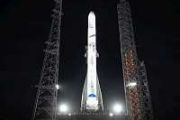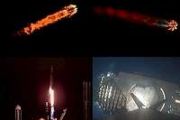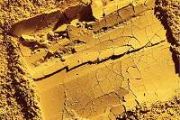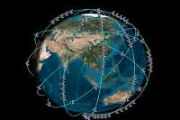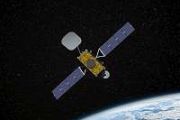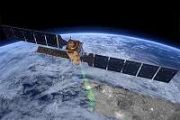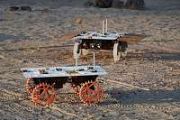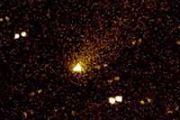
Copernical Team
NASA's Webb to Uncover Riches of the Early Universe
 For decades, telescopes have helped us capture light from galaxies that formed as far back as 400 million years after the big bang - incredibly early in the context of the universe's 13.8-billion-year history. But what were galaxies like that existed even earlier, when the universe was semi-transparent at the beginning of a period known as the Era of Reionization?
NASA's next flagship obse
For decades, telescopes have helped us capture light from galaxies that formed as far back as 400 million years after the big bang - incredibly early in the context of the universe's 13.8-billion-year history. But what were galaxies like that existed even earlier, when the universe was semi-transparent at the beginning of a period known as the Era of Reionization?
NASA's next flagship obse China launches new test satellite
 China on Wednesday sent a new satellite into space from the Jiuquan Satellite Launch Center in northwest China.
The Tianxing-1 test satellite was launched by a Kuaizhou-1A carrier rocket at 10:08 a.m. (Beijing Time) and entered the planned orbit.
The satellite is mainly used for experiments such as space environment detection.
It was the 15th flight mission of the Kuaizhou-1A r
China on Wednesday sent a new satellite into space from the Jiuquan Satellite Launch Center in northwest China.
The Tianxing-1 test satellite was launched by a Kuaizhou-1A carrier rocket at 10:08 a.m. (Beijing Time) and entered the planned orbit.
The satellite is mainly used for experiments such as space environment detection.
It was the 15th flight mission of the Kuaizhou-1A r Key milestones achieved in Manned-Unmanned Teaming for future air power
 The ability to task unmanned systems from a manned aircraft is an important force multiplier in Airbus' vision for future air power, with a wide range of applications extending to combat scenarios and beyond.
As a pioneer in the realm of Manned-Unmanned Teaming (MUM-T), Airbus has developed an ambitious technological roadmap to make this innovative concept - which boosts the effectiveness
The ability to task unmanned systems from a manned aircraft is an important force multiplier in Airbus' vision for future air power, with a wide range of applications extending to combat scenarios and beyond.
As a pioneer in the realm of Manned-Unmanned Teaming (MUM-T), Airbus has developed an ambitious technological roadmap to make this innovative concept - which boosts the effectiveness Globalstar announces successful launch of spare satellite
 Globalstar, Inc. (NYSE American: GSAT), a leading provider of satellite-powered innovation, has announced the successful launch of the FM-15 spare satellite from Cape Canaveral's Kennedy Space Center. FM-15 is the 25th and final satellite of Globalstar's second-generation constellation, which was manufactured and stored by Thales Alenia Space.
The satellite is expected to remain as an in-o
Globalstar, Inc. (NYSE American: GSAT), a leading provider of satellite-powered innovation, has announced the successful launch of the FM-15 spare satellite from Cape Canaveral's Kennedy Space Center. FM-15 is the 25th and final satellite of Globalstar's second-generation constellation, which was manufactured and stored by Thales Alenia Space.
The satellite is expected to remain as an in-o Lockheed Martin partners with US Indo-Pacific Command in Multi-Domain Experiments
 Lockheed Martin paired its DIAMONDShield battle management system with four Virtualized Aegis Weapon System (VAWS) nodes deployed across hundreds of miles to successfully demonstrate multi-domain operations during a recent U.S. military exercise.
The exercise, called Valiant Shield 2022, is a biennial training activity involving thousands of U.S. military personnel and more than 200 ships,
Lockheed Martin paired its DIAMONDShield battle management system with four Virtualized Aegis Weapon System (VAWS) nodes deployed across hundreds of miles to successfully demonstrate multi-domain operations during a recent U.S. military exercise.
The exercise, called Valiant Shield 2022, is a biennial training activity involving thousands of U.S. military personnel and more than 200 ships, First Ariane 5 launch of 2022 is a success for Malaysia and India clients
 On Wednesday, June 22, 2022 at 06:50 pm local time, an Ariane 5 launcher lifted off from the Guiana Space Center, Europe's Spaceport in Kourou, French Guiana (South America), successfully orbiting two geostationary telecommunication satellites, MEASAT-3d and GSAT-24.
"With this Ariane 5 mission, Arianespace is honored to support the ambitions of two key actors in the Asia-Pacific region: M
On Wednesday, June 22, 2022 at 06:50 pm local time, an Ariane 5 launcher lifted off from the Guiana Space Center, Europe's Spaceport in Kourou, French Guiana (South America), successfully orbiting two geostationary telecommunication satellites, MEASAT-3d and GSAT-24.
"With this Ariane 5 mission, Arianespace is honored to support the ambitions of two key actors in the Asia-Pacific region: M NASA's Curiosity Captures Stunning Views of a Changing Mars Landscape
 Striking rock formations documented by the rover provide evidence of a drying climate in the Red Planet's ancient past.
For the past year, NASA's Curiosity Mars rover has been traveling through a transition zone from a clay-rich region to one filled with a salty mineral called sulfate. While the science team targeted the clay-rich region and the sulfate-laden one for evidence each can offe
Striking rock formations documented by the rover provide evidence of a drying climate in the Red Planet's ancient past.
For the past year, NASA's Curiosity Mars rover has been traveling through a transition zone from a clay-rich region to one filled with a salty mineral called sulfate. While the science team targeted the clay-rich region and the sulfate-laden one for evidence each can offe A Long History of Flowing Water Recorded in Clay-Bearing Sediments on Mars
 A region on Mars may have been repeatedly habitable until relatively late in Martian history, says a new paper by Planetary Science Institute Senior Scientist Catherine Weitz.
Some of the most extensively preserved landforms on Mars created by running water on its surface are found within the Margaritifer Terra region where deposits of clay-bearing sediments have been identified. "The pres
A region on Mars may have been repeatedly habitable until relatively late in Martian history, says a new paper by Planetary Science Institute Senior Scientist Catherine Weitz.
Some of the most extensively preserved landforms on Mars created by running water on its surface are found within the Margaritifer Terra region where deposits of clay-bearing sediments have been identified. "The pres China looks set to build space solar power station
 China has made a milestone advance in its effort to build a solar power station in space to convert the sunlight in outer space into an electrical supply to drive the satellites in orbits or transmit power back to the Earth.
A research team from Xidian University has wrapped up the world's first full-chain, system-wide ground verification for space solar power station this month, displayin
China has made a milestone advance in its effort to build a solar power station in space to convert the sunlight in outer space into an electrical supply to drive the satellites in orbits or transmit power back to the Earth.
A research team from Xidian University has wrapped up the world's first full-chain, system-wide ground verification for space solar power station this month, displayin A modern space race needs to be built on sustainability
 Researchers have called for a more sustainable approach to the UK's National Space Strategy in a new publication from The University of Manchester, On Space.
Based on leading research and expertise on innovative and emerging technologies, experts are calling for sustainability to be at the forefront of humanity's next phase of space exploration. In On Space, experts ask policymakers to con
Researchers have called for a more sustainable approach to the UK's National Space Strategy in a new publication from The University of Manchester, On Space.
Based on leading research and expertise on innovative and emerging technologies, experts are calling for sustainability to be at the forefront of humanity's next phase of space exploration. In On Space, experts ask policymakers to con 










